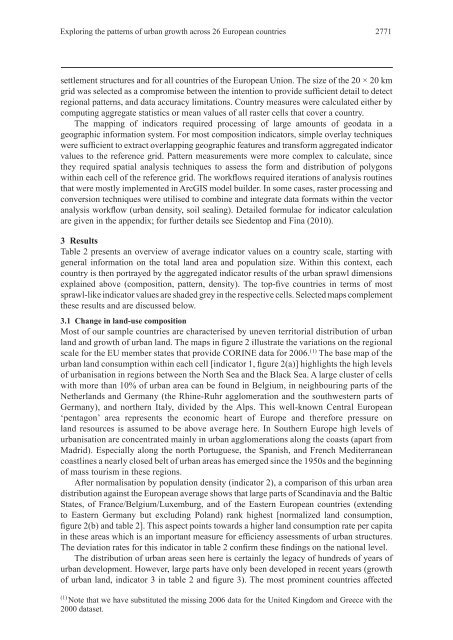PDF 20.134kB - TOBIAS-lib - Universität Tübingen
PDF 20.134kB - TOBIAS-lib - Universität Tübingen
PDF 20.134kB - TOBIAS-lib - Universität Tübingen
Sie wollen auch ein ePaper? Erhöhen Sie die Reichweite Ihrer Titel.
YUMPU macht aus Druck-PDFs automatisch weboptimierte ePaper, die Google liebt.
Exploring the patterns of urban growth across 26 European countries 2771<br />
settlement structures and for all countries of the European Union. The size of the 20 × 20 km<br />
grid was selected as a compromise between the intention to provide suf cient detail to detect<br />
regional patterns, and data accuracy limitations. Country measures were calculated either by<br />
computing aggregate statistics or mean values of all raster cells that cover a country.<br />
The mapping of indicators required processing of large amounts of geodata in a<br />
geographic information system. For most composition indicators, simple overlay techniques<br />
were suf cient to extract overlapping geographic features and transform aggregated indicator<br />
values to the reference grid. Pattern measurements were more complex to calculate, since<br />
they required spatial analysis techniques to assess the form and distribution of polygons<br />
within each cell of the reference grid. The work ows required iterations of analysis routines<br />
that were mostly implemented in ArcGIS model builder. In some cases, raster processing and<br />
conversion techniques were utilised to combine and integrate data formats within the vector<br />
analysis work ow (urban density, soil sealing). Detailed formulae for indicator calculation<br />
are given in the appendix; for further details see Siedentop and Fina (2010).<br />
3 Results<br />
Table 2 presents an overview of average indicator values on a country scale, starting with<br />
general information on the total land area and population size. Within this context, each<br />
country is then portrayed by the aggregated indicator results of the urban sprawl dimensions<br />
explained above (composition, pattern, density). The top- ve countries in terms of most<br />
sprawl-like indicator values are shaded grey in the respective cells. Selected maps complement<br />
these results and are discussed below.<br />
3.1 Change in land-use composition<br />
Most of our sample countries are characterised by uneven territorial distribution of urban<br />
land and growth of urban land. The maps in gure 2 illustrate the variations on the regional<br />
scale for the EU member states that provide CORINE data for 2006. (1) The base map of the<br />
urban land consumption within each cell [indicator 1, gure 2(a)] highlights the high levels<br />
of urbanisation in regions between the North Sea and the Black Sea. A large cluster of cells<br />
with more than 10% of urban area can be found in Belgium, in neighbouring parts of the<br />
Netherlands and Germany (the Rhine-Ruhr agglomeration and the southwestern parts of<br />
Germany), and northern Italy, divided by the Alps. This well-known Central European<br />
‘pentagon’ area represents the economic heart of Europe and therefore pressure on<br />
land resources is assumed to be above average here. In Southern Europe high levels of<br />
urbanisation are concentrated mainly in urban agglomerations along the coasts (apart from<br />
Madrid). Especially along the north Portuguese, the Spanish, and French Mediterranean<br />
coastlines a nearly closed belt of urban areas has emerged since the 1950s and the beginning<br />
of mass tourism in these regions.<br />
After normalisation by population density (indicator 2), a comparison of this urban area<br />
distribution against the European average shows that large parts of Scandinavia and the Baltic<br />
States, of France/Belgium/Luxemburg, and of the Eastern European countries (extending<br />
to Eastern Germany but excluding Poland) rank highest [normalized land consumption,<br />
gure 2(b) and table 2]. This aspect points towards a higher land consumption rate per capita<br />
in these areas which is an important measure for ef ciency assessments of urban structures.<br />
The deviation rates for this indicator in table 2 con rm these ndings on the national level.<br />
The distribution of urban areas seen here is certainly the legacy of hundreds of years of<br />
urban development. However, large parts have only been developed in recent years (growth<br />
of urban land, indicator 3 in table 2 and gure 3). The most prominent countries affected<br />
(1) Note that we have substituted the missing 2006 data for the United Kingdom and Greece with the<br />
2000 dataset.

















